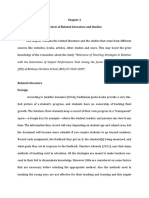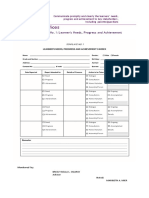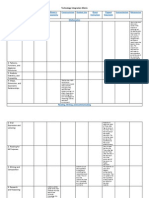0 ratings0% found this document useful (0 votes)
64 viewsErkins
Erkins
Uploaded by
api-104924860The traditional way students are assessed is no longer viable, an expert says. Students would receive their tests back along with a self-assessment sheet. "It helps engage them in their own learning," a teacher says.
Copyright:
Attribution Non-Commercial (BY-NC)
Available Formats
Download as DOCX, PDF, TXT or read online from Scribd
Erkins
Erkins
Uploaded by
api-1049248600 ratings0% found this document useful (0 votes)
64 views2 pagesThe traditional way students are assessed is no longer viable, an expert says. Students would receive their tests back along with a self-assessment sheet. "It helps engage them in their own learning," a teacher says.
Original Title
erkins
Copyright
© Attribution Non-Commercial (BY-NC)
Available Formats
DOCX, PDF, TXT or read online from Scribd
Share this document
Did you find this document useful?
Is this content inappropriate?
The traditional way students are assessed is no longer viable, an expert says. Students would receive their tests back along with a self-assessment sheet. "It helps engage them in their own learning," a teacher says.
Copyright:
Attribution Non-Commercial (BY-NC)
Available Formats
Download as DOCX, PDF, TXT or read online from Scribd
Download as docx, pdf, or txt
0 ratings0% found this document useful (0 votes)
64 views2 pagesErkins
Erkins
Uploaded by
api-104924860The traditional way students are assessed is no longer viable, an expert says. Students would receive their tests back along with a self-assessment sheet. "It helps engage them in their own learning," a teacher says.
Copyright:
Attribution Non-Commercial (BY-NC)
Available Formats
Download as DOCX, PDF, TXT or read online from Scribd
Download as docx, pdf, or txt
You are on page 1of 2
Archives
Teachers Iearn about new assessment techniques
By Rob Swystun, CentraI PIains HeraId-Leader
Posted 1 year ago
How students are assessed in school was the subject of a work session hosted by the Portage la Prairie School
Division Tuesday and Wednesday.
The school division invited Cassandra Erkens with the Assessment Trainers nstitute in Portland, Ore., to conduct a
workshop about formative assessment of students in the classroom.
Erkens said the traditional way students are assessed is no longer viable. That would usually consist of students
taking an examination, receiving their grade and simply moving onto the next lesson. Formative assessment, she
said, includes students in the process.
"Kids need to be partners in the journey," she said in an interview during a break in the workshop at the Portage
ndustrial Exhibition Association office Wednesday.
With the formative assessment, she noted, students would receive their tests back along with a self-assessment
sheet where they could go through the test and check for themselves not just what questions they got wrong, but why
they got them wrong. They'll be able to check if it was a matter of just not doing the exercise correctly or if they really
didn't understand the question at all.
This will help them identify their own weaknesses, Erkens noted.
Erkens said she was quite happy with how open participants were at the Portage workshop. The reason why
participants were so open may be because most schools in and around Portage are already using some sort of form
of it already.
Winnie Ferguson, who teaches science and physical education for middle year students at Austin Elementary School,
said teachers have already been doing student self and peer assessments and the workshop was a way for them to
build on what they've been doing at the school with more ideas and resources.
Ferguson said the formative assessment is an important factor in students' education.
"t helps engage them in their own learning," she observed.
Representatives from Pine Creek School Division, which includes Austin Elementary School, will take the information
garnered from the workshop back to their respective schools and decide best how to utilize the new techniques
they've learned, she said.
Formative assessment also involves having the students setting goals for themselves and tracking their own progress
on the subjects they are studying, the session presenter said.
"We have to be clear about our learning expectations from them," Erkens said, adding that formative assessment
could begin as soon as a child begins school.
She has personally seen kindergarten classes performing peer evaluation on each other's writing, she said, and can
attest to the improvement the peer assessment provides to them.
Formative assessment was originally conceived back in the 1960s, Erkens explained, but it really exploded
internationally in 1998 when a study was released that showed vast improvement to students who performed that
type of assessment over traditional classroom assessment.
Several separate studies have been done since on the subject, all pointing to the same thing, she said, that formative
assessment greatly improves students' learning.
Erkens' presentation focused on seven strategies to help teachers in the classroom with formative assessment.
Those included: providing students with a clear and understandable vision of the learning target, using examples and
models of strong and weak work, offering regular descriptive feedback, teaching students to self-assess and set
goals, designing lessons to focus on one learning target or aspect of quality at a time, teaching students how to
revise their focus on a subject and engaging students in self-reflection and letting them keep track of and share their
learning.
Pine Creek wasn't the only organization represented.
Donna Mueller, strategic initiatives learning co-ordinator with the Portage School Division, said 60 guests took in the
workshop, including representatives from the Portage la Prairie, Borderland, Prairie Rose, Prairie Spirit and Brandon
School Divisions.
"We've got Manitoba Edu-cation here, as well," Mueller said.
The provincial government has taken quite an interest in formative assessment, the strategic initiatives learning co-
ordinator said.
"t's actually a provincial initiative that school divisions look at this," she noted.
The provincial government wants school divisions to take what they learn about formative assessment back to their
respective schools to share with the staff there, much like what will happen with Austin Elementary School.
Those representatives will then meet again next year to discuss how the formative assessment affected learning in
their schools, she said.
Do you have a comment on this story? Have your say at www.thedailygraphic.com.
rswystun@cpheraldleader.com
You might also like
- Lived Experiences of The Public High School TeachersDocument23 pagesLived Experiences of The Public High School TeachersHoneyjay Canoy100% (4)
- The Lego Mindstorms Ev3 Discovery BookDocument5 pagesThe Lego Mindstorms Ev3 Discovery BookPrapussorn Sresanunwong13% (8)
- Patej Research-Based Assessment PracticeDocument8 pagesPatej Research-Based Assessment Practiceapi-507631357No ratings yet
- Edu 650 - Week 5 Final ProjectDocument5 pagesEdu 650 - Week 5 Final Projectapi-259186679No ratings yet
- Cultural Care Diversity and Universality TheoryDocument34 pagesCultural Care Diversity and Universality TheorySuryanti AryaitNo ratings yet
- Ed 676 AssessmentphilosophyDocument9 pagesEd 676 Assessmentphilosophyapi-47041391No ratings yet
- Prospectus Version 2.8Document24 pagesProspectus Version 2.8Amanda L. WilsonNo ratings yet
- Prospectus Version 2.85Document24 pagesProspectus Version 2.85Amanda L. WilsonNo ratings yet
- Chapter-2-Incomplete (1)Document6 pagesChapter-2-Incomplete (1)Jimlord Garcia100% (1)
- Amandanewcomb Prq4finalDocument5 pagesAmandanewcomb Prq4finalapi-352269670No ratings yet
- Prospectus Version 2.7Document23 pagesProspectus Version 2.7Amanda L. WilsonNo ratings yet
- A R FinalDocument22 pagesA R Finalapi-273472842No ratings yet
- Document PDFDocument10 pagesDocument PDFJohn Andrei FloresNo ratings yet
- Chapter-2-Incomplete (Nagdagdag Lang)Document9 pagesChapter-2-Incomplete (Nagdagdag Lang)Jimlord GarciaNo ratings yet
- Self-Reflection-Research MethodologyDocument4 pagesSelf-Reflection-Research Methodologyapi-369459770No ratings yet
- Philosophy of EducationDocument4 pagesPhilosophy of Educationapi-416042581No ratings yet
- Chapter-2-Needs-To-Be-Revised (2)Document5 pagesChapter-2-Needs-To-Be-Revised (2)Jimlord GarciaNo ratings yet
- The Role of The Teacher in A PersonalizedDocument4 pagesThe Role of The Teacher in A PersonalizedAnonymous wVUdtzW1FNo ratings yet
- ED579279Document13 pagesED579279itadori yuujiNo ratings yet
- Reflection PaperDocument8 pagesReflection PaperMr xyNo ratings yet
- Philosophy of Assessment WordDocument8 pagesPhilosophy of Assessment Wordapi-242399099No ratings yet
- Ed698 10 1Document4 pagesEd698 10 1api-664166199No ratings yet
- Critical Article Review 2Document8 pagesCritical Article Review 2Aimi Dayana JaafarNo ratings yet
- Professional Inquiry Project Report: FocusDocument11 pagesProfessional Inquiry Project Report: Focusapi-426793470No ratings yet
- Chapter 1Document18 pagesChapter 1LeZeth MarlNo ratings yet
- Article Review: EDU580: Co-Curriculum ManagementDocument9 pagesArticle Review: EDU580: Co-Curriculum ManagementMuhammad Amir AkramNo ratings yet
- Assessment 10 FinalDocument7 pagesAssessment 10 Finalapi-346891460No ratings yet
- Statassa 1Document14 pagesStatassa 1jerainmallari12No ratings yet
- Compenent ADocument2 pagesCompenent Aapi-331716138No ratings yet
- Artifact Paper 2Document4 pagesArtifact Paper 2api-434261972No ratings yet
- Link Teacher Pay To PerformanceDocument4 pagesLink Teacher Pay To Performanceslipi14No ratings yet
- Case Study - GranaDocument21 pagesCase Study - Granahanna angelineNo ratings yet
- Alexa Hollingsworth - Classroom Environment Philosophy CepDocument12 pagesAlexa Hollingsworth - Classroom Environment Philosophy Cepapi-532102896No ratings yet
- What Works in A Pandemic?: Maximizing FB Messenger To Monitor, Assess and Evaluate Outputs of Selected SCES Grade Six PupilsDocument9 pagesWhat Works in A Pandemic?: Maximizing FB Messenger To Monitor, Assess and Evaluate Outputs of Selected SCES Grade Six PupilsPsychology and Education: A Multidisciplinary JournalNo ratings yet
- Article Formative-Assessment PDFDocument12 pagesArticle Formative-Assessment PDFChip D. Teach100% (1)
- PR 1Document9 pagesPR 1kurtfaustino18No ratings yet
- An Assessment of The Non-Graded System Based On Learners' Learning Satisfaction, Behavior, and Outcomes PDFDocument19 pagesAn Assessment of The Non-Graded System Based On Learners' Learning Satisfaction, Behavior, and Outcomes PDFGlobal Research and Development ServicesNo ratings yet
- Assessment-Based Instruction PaperDocument7 pagesAssessment-Based Instruction Paperapi-250313253No ratings yet
- Using Student Involved Classroom Assessment To Close Achievement GapsDocument4 pagesUsing Student Involved Classroom Assessment To Close Achievement Gapsapi-628146149No ratings yet
- Peer Tutoring Final PaperDocument9 pagesPeer Tutoring Final Paperapi-251993533No ratings yet
- Running Head: Planning, Preparation, Instruction, and Assessment 1Document5 pagesRunning Head: Planning, Preparation, Instruction, and Assessment 1api-306418413No ratings yet
- Philosophy of AssessmentDocument10 pagesPhilosophy of Assessmentapi-404083519No ratings yet
- Related StudiesDocument4 pagesRelated StudiesLovely Joy Donaire RegorosaNo ratings yet
- Scaling The Academic Ladder: Enhancing In-Service Training For Teachers Through Educational AttainmentDocument7 pagesScaling The Academic Ladder: Enhancing In-Service Training For Teachers Through Educational AttainmentPsychology and Education: A Multidisciplinary JournalNo ratings yet
- Grey and White Creative Scrapbook Project Presentation (8 X 11 In)Document63 pagesGrey and White Creative Scrapbook Project Presentation (8 X 11 In)Abegail CalijanNo ratings yet
- The Impact of Extracurricular Activities On The Acedemic PerformancesDocument10 pagesThe Impact of Extracurricular Activities On The Acedemic Performancesgard3606No ratings yet
- Final - All Edits 1Document9 pagesFinal - All Edits 1api-293219537No ratings yet
- AssessmentphilosophyDocument4 pagesAssessmentphilosophyapi-333161760No ratings yet
- Assessment PhilosophyDocument6 pagesAssessment Philosophyapi-264963856No ratings yet
- Educ 5440 Discussion Assignment 7Document2 pagesEduc 5440 Discussion Assignment 7Olaniyi IsaacNo ratings yet
- Aksum UniversityDocument27 pagesAksum UniversityAbraham BarrekaNo ratings yet
- Week 2 Revised Balanced Assessment Plan - NDocument40 pagesWeek 2 Revised Balanced Assessment Plan - Napi-423909625No ratings yet
- New RRL and RrsDocument17 pagesNew RRL and RrsNicole Aizhy NuenaNo ratings yet
- Neslie 2023 074114Document27 pagesNeslie 2023 074114sanchezryanpoorNo ratings yet
- CIG 697 Directed Learning Experience EditedDocument14 pagesCIG 697 Directed Learning Experience EditedAmy SorensenNo ratings yet
- Final Research 103Document58 pagesFinal Research 103RS Buenavista100% (1)
- Title: Improving Formative Assessment Style Under The New Normal: Overcoming LearningDocument12 pagesTitle: Improving Formative Assessment Style Under The New Normal: Overcoming LearningChristian Dick B. CunagNo ratings yet
- 9principles PDFDocument3 pages9principles PDFCarmel T. PoNo ratings yet
- Final Final Paper!Document8 pagesFinal Final Paper!api-264481356No ratings yet
- Classroom-Ready Resources for Student-Centered Learning: Basic Teaching Strategies for Fostering Student Ownership, Agency, and Engagement in K–6 ClassroomsFrom EverandClassroom-Ready Resources for Student-Centered Learning: Basic Teaching Strategies for Fostering Student Ownership, Agency, and Engagement in K–6 ClassroomsNo ratings yet
- Enrichment Clusters: A Practical Plan for Real-World, Student-Driven LearningFrom EverandEnrichment Clusters: A Practical Plan for Real-World, Student-Driven LearningRating: 5 out of 5 stars5/5 (1)
- StudentserviceslofrDocument1 pageStudentserviceslofrapi-104924860No ratings yet
- Donna Mestdagh Colleague ReferenceDocument2 pagesDonna Mestdagh Colleague Referenceapi-104924860No ratings yet
- GuitarbuildingprojectDocument2 pagesGuitarbuildingprojectapi-104924860No ratings yet
- FridaygraphicrcDocument3 pagesFridaygraphicrcapi-104924860No ratings yet
- Later LiteracyDocument1 pageLater Literacyapi-104924860No ratings yet
- FrenchDocument2 pagesFrenchapi-104924860No ratings yet
- Development PlanDocument10 pagesDevelopment PlanVicenta C. San FelipeNo ratings yet
- Basic Lead CBLMDocument80 pagesBasic Lead CBLMjazzy mallariNo ratings yet
- Appendices: Template No. 1: Learner's Needs, Progress and Achievement CardexDocument4 pagesAppendices: Template No. 1: Learner's Needs, Progress and Achievement CardexJesson AlbaranNo ratings yet
- Virtual Validation of SBM Levels of PracticeDocument20 pagesVirtual Validation of SBM Levels of Practicejohn rex57% (7)
- Table of Education VocabularyDocument2 pagesTable of Education VocabularyVlad VargauNo ratings yet
- How To Use Performance Ratings enDocument3 pagesHow To Use Performance Ratings enRajesh RajendranNo ratings yet
- Research - Munuscript FinalDocument45 pagesResearch - Munuscript FinalPrincess Jean TahumNo ratings yet
- Romeo Juliet Act 1Document15 pagesRomeo Juliet Act 1api-377713383No ratings yet
- Cambridge Reading Adventures Wellbeing Brochure - tcm142-696504Document22 pagesCambridge Reading Adventures Wellbeing Brochure - tcm142-696504w.enninfulNo ratings yet
- Why Do Some People Have An Accent?: The Linguistic Society of America Was FoundedDocument2 pagesWhy Do Some People Have An Accent?: The Linguistic Society of America Was FoundedkdjfkdsjfkdsjdkNo ratings yet
- DNA of Customer ExperianceDocument34 pagesDNA of Customer ExperiancerizkielimbongNo ratings yet
- A Pathway To Equitable Math Instruction IdentityDocument25 pagesA Pathway To Equitable Math Instruction IdentityThePoliticalHatNo ratings yet
- MLA 8th Edition Paper TemplateDocument3 pagesMLA 8th Edition Paper TemplateGuadalupe TolabaNo ratings yet
- RPH English Year 3Document10 pagesRPH English Year 3Dent KhairuddinNo ratings yet
- SS DLL Week 1Document4 pagesSS DLL Week 1Jaasiel Isaguirre GarciaNo ratings yet
- Syllabus PsycholinguisticsDocument3 pagesSyllabus Psycholinguisticsyudi909No ratings yet
- Narrative Report of My Teaching DemonstrationDocument2 pagesNarrative Report of My Teaching Demonstrationfries riveraNo ratings yet
- NBA-Template-Attainment Sheet in Course FileDocument9 pagesNBA-Template-Attainment Sheet in Course Fileyouga Sri0% (1)
- Technology Integration MatrixDocument4 pagesTechnology Integration Matrixapi-278817625No ratings yet
- Handa 102605 Ppce Aut 2021 ReportDocument1 pageHanda 102605 Ppce Aut 2021 Reportapi-554345821No ratings yet
- Impact of Training and Development On Employee's Performance at INDIAN OILDocument65 pagesImpact of Training and Development On Employee's Performance at INDIAN OILWebsoft Tech-Hyd100% (1)
- Entrepreneurial RevolutionDocument4 pagesEntrepreneurial RevolutionNirajan MahatoNo ratings yet
- Handouts For Semantics GradDocument12 pagesHandouts For Semantics GradChanh MuốiNo ratings yet
- Review of Related Literature Impact of Covid-19Document11 pagesReview of Related Literature Impact of Covid-19Sky ChingNo ratings yet
- Design Thinking For Mechanical ProjectsDocument8 pagesDesign Thinking For Mechanical ProjectsNarayanan SubramanianNo ratings yet
- Unit 19 p3Document10 pagesUnit 19 p3api-344079053No ratings yet
- Grade 1 Phonics and Word RecognitionDocument21 pagesGrade 1 Phonics and Word RecognitionLa-ongan DevorahNo ratings yet
- Research Survey QuestionnaireDocument3 pagesResearch Survey QuestionnaireReshane SoberanoNo ratings yet































































































